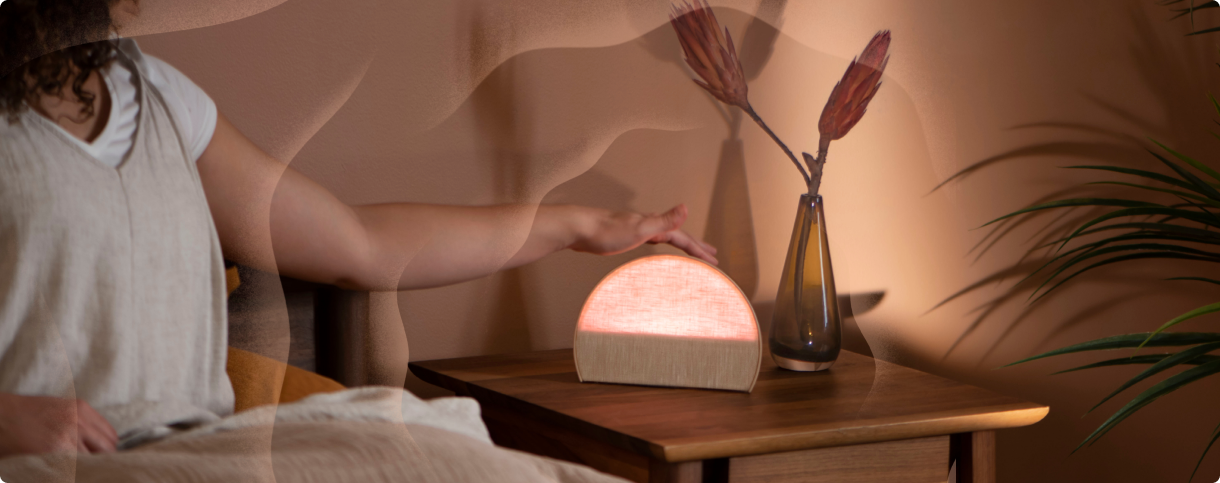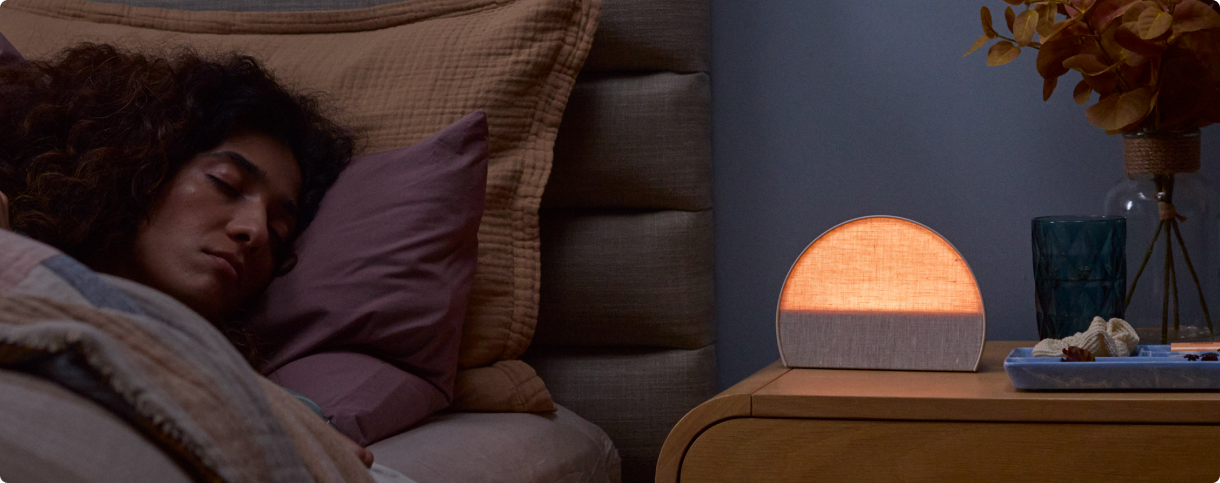Everything You Need To Know About Light and Your Sleep Cycle
We work hard to curate our home decor to reflect our personality and taste because we know that the physical environment plays a huge role in everyday life. But the impact of light -- its color and intensity -- is often overlooked. And it can be a game-changer for mood, focus, rest, and sleep.
Maybe your morning and night-time routines feel second nature to you, but wakefulness and sleep are actually complex processes set in motion by outside cues. One of the most important components impacting your ability to wake up and fall asleep is light. That’s why experts recommend plenty of sunlight exposure in the morning and minimizing screen time at night to support your circadian rhythm.
Not all forms or colors of light are created equal, and understanding the different types and their qualities can help you get better sleep — and even feel more productive when you’re awake. Below, learn more about how the colors of the rainbow can impact your circadian rhythm -- and how you can use them to improve your sleep and other daily activities.
Light and your circadian rhythm
Your circadian rhythm is all the physical and mental changes that happen in your body over a 24-hour period — including your brain’s ability to determine what time it is and trigger chemicals in your body that help you wake up or doze off. To determine what time of day it is, your brain relies on several external signals. “One of the strongest cues for your circadian rhythm is light,” says Jade Wu, Ph.D., a behavioral sleep psychologist, researcher at Duke University School of Medicine, and Hatch medical advisor.
In the morning, light tells your brain that it's time to wake up, triggering the release of chemicals that help energize you. Then, as light dwindles later in the day, your brain starts to secrete chemicals that make you sleepy (namely, melatonin). While light is an important factor in supporting your circadian rhythm, and helping you sleep, different types of light have different qualities.
Remember ROYGBIV? Some of us may remember learning the order of the colors in the rainbow -- red, orange, yellow, green, blue, indigo, violet -- from that handy mnemonic device. But the rainbow of colors your eyes can see — a surprisingly small sliver of the electromagnetic spectrum — is called visible light. Different colors of light your eyes can see are measured in wavelengths, and each one has different properties, says Jessee Dietch, Ph.D., a behavioral sleep psychologist, researcher at Oregon State University, and Hatch medical advisor.
Generally, shorter wavelengths — like blue and green — affect the circadian rhythm more. “Short wavelengths are the ones that really tell the brain it’s daytime and suppress melatonin secretion,” says Dr. Wu. “Normally it ramps up in the evening, stays high all night, and drops off in the early morning when it’s suppressed by light.” On the flip side, longer-wavelength light — think sunset colors, like orange and red — are less likely to impact your circadian rhythm.
A tip from Hatch: If you have a Hatch Restore device, you can explore a variety of rich sunset hues to help you unwind before bed.
Each color can impact your body and mind differently, and these characteristics are important to understand if you’re trying to optimize your sleep-wake schedule.

White
White, as you may have learned in elementary school, is a combination of all the other colors. Scientists call white “broad-spectrum” light for that reason — it encompasses the entire spectrum. In nature, white light is most common when most of us are wide awake. “At high noon, that’s the kind of light you’re getting,” says Dr. Dietch.
Light therapy lamps, which can be used to simulate sunlight exposure, typically include white light. So do lightbulbs used to help indoor plants grow. Because the full spectrum includes blue and green wavelengths known to impact melatonin secretion, Dr. Dietch says white light settings on a lamp can feel stimulating or energizing (and isn’t a good idea before bed).
A tip from Hatch: All of Hatch’s devices have options for using light to help you rise in the morning. A sunrise alarm can help support wakefulness by supporting your natural circadian rhythm.

Blue
Blue is among the shortest wavelengths in the electromagnetic spectrum, and it’s one of the most likely to impact your circadian rhythm. Exposure to blue light, commonly exerted by electronics like your phone or tablet, essentially tells your brain it’s daytime — so it halts melatonin secretion and encourages wakefulness.
Dr. Dietch says this can be helpful during the day but not so helpful at night when you’re trying to wind down before bed. Try to limit blue light exposure a few hours before bed, when possible, to encourage better sleep.

Green
Like blue light, green light is made up of short wavelengths that exert an impact on your circadian rhythm. If your goal is an energy boost, green light could be a good pick. But make sure not to use green light too close to bedtime or you may struggle to fall and stay asleep.
Red
On the other end of the spectrum is red light. In nature, we see red hues most commonly during the sunset, which makes sense given red’s lesser effect on your brain. Red light is made up of longer wavelengths, which are more neutral when it comes to your circadian rhythm. “Long wavelengths don’t necessarily make us sleepy, but they allow melatonin to come through, which helps you feel tired,” says Dr. Wu. If you’re searching for a nightlight that’ll provide just enough light for you to grab a sip of water at 3 AM but won’t keep you awake, then red light could be a good way to go.
A tip from Hatch: Add a red light to your wind-down routine to set a dreamy mood while still gently lighting your room.

Yellow and orange
Similar to red light, yellow and orange are primarily composed of longer wavelengths. Dr. Dietch says it’s a happy medium in the electromagnetic spectrum of light: It may have some impact on your circadian rhythm, but it’s not as impactful as blue and green light.


How to use light to enhance your routines
Light can be a useful tool if you’re trying to establish your circadian rhythm (or someone else’s, like a baby or child). Aim to increase your light exposure in the morning, whether you go outside for a walk or invest in a light therapy lamp or sunrise alarm, and continue getting as much sunlight as possible throughout the day. Exposure to broad-spectrum light from the sun can be stimulating, so opening the blinds in your office or popping outside for a quick walk may give you a boost.
As you’re shifting from wakefulness to rest mode, shift your light exposure, too. A few hours before bed, limit the use of screens so you don’t unintentionally signal to your brain it’s daytime. “The later it is in the evening, the longer the wavelength and dimmer you want things to be,” says Dr. Wu.
Your brain does well with context clues, so Dr. Wu says if you get more light during the day, you can theoretically buy yourself some more blue light time at night — but don’t overdo it, because electronics can be stimulating in other ways and might trigger anxiety or excitement when you want to be winding down for rest.
Darkness is best for sleep, but if you need a nightlight, steer clear of stimulating colors and opt for a dim red or orange light that won’t affect your circadian rhythm. By the time you wake up in the morning — especially with the help of a little broad-spectrum light— your body should get the memo that it’s time to release all those chemicals that help you go about your day feeling productive and energized.